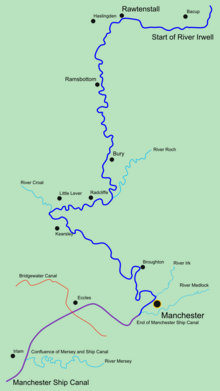
Back نهر ايرويل ARZ River Irwell BAR River Irwell CEB Irwell Czech Ирвелл CV River Irwell German Río Irwell Spanish رود ایرول Persian Irwell French Irwell (rivier yn Ingelân) Frisian
| River Irwell | |
|---|---|
 The River Irwell at Salford, looking towards Manchester city centre | |
 | |
| Location | |
| Country | United Kingdom |
| Constituent country | England |
| Region | North West England |
| Physical characteristics | |
| Source | Irwell Springs |
| • location | Deerplay Moor, Cliviger, Lancashire |
| • coordinates | 53°44′10″N 2°11′59″W / 53.73611°N 2.19972°W |
| • elevation | 400 m (1,300 ft) |
| Mouth | River Mersey |
• location | Manchester Ship Canal, Irlam |
| Length | 63 km (39 mi) |
| Discharge | |
| • location | Adelphi Weir |
| • average | 17.72 m3/s (626 cu ft/s) |
| Basin features | |
| Tributaries | |
| • left | Croal |
| • right | Roch, Irk, Medlock |
The River Irwell (/ˈɜːrwɛl/ UR-wel) is a tributary of the River Mersey in north-west England. It rises at Irwell Springs on Deerplay Moor, approximately 1+1⁄2 miles (2.5 kilometres) north of Bacup and flows southwards for 39 mi (63 km) to meet the Mersey near Irlam. The Irwell marks the boundary between Manchester and Salford, and its lower reaches have been canalised and now form part of the Manchester Ship Canal.
In the 17th and 18th centuries, the Irwell's lower reaches were a trading route that became part of the Mersey and Irwell Navigation. In the 19th century, the river's course downstream of Manchester was permanently altered by the construction of the Manchester Ship Canal which opened in 1896. The canal turned Manchester and Salford into a major inland seaport and led to the development of Trafford Park, which became the largest industrial estate in Europe. Further changes were made in the 20th and 21st centuries to prevent flooding in Manchester and Salford, including the construction of the Anaconda Cut in 1970 and the River Irwell Flood Defence Scheme in 2014.
The river became severely polluted by industrial waste during the Industrial Revolution, but in the second half of the 20th century a number of initiatives were implemented to improve water quality, restock it with fish and create a diverse environment for wildlife. Stretches of the river flowing through Manchester and Salford have attracted large-scale investment in business and residential developments, such as Salford Quays, and other parts have become important wildlife havens. The Irwell is used for recreational activities, such as pleasure cruising, rowing, racing, swimming and fishing.
© MMXXIII Rich X Search. We shall prevail. All rights reserved. Rich X Search